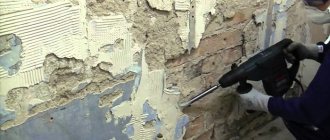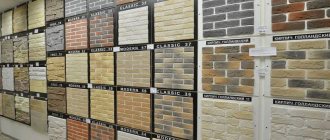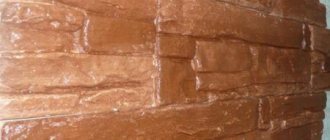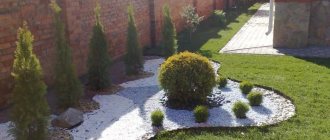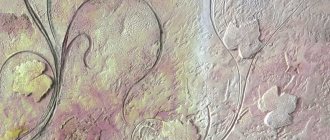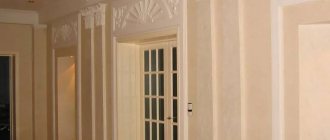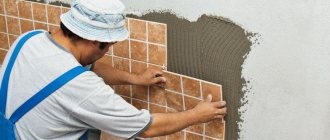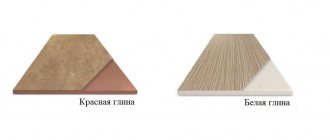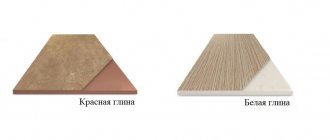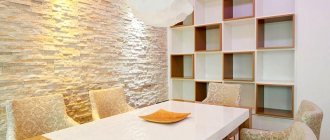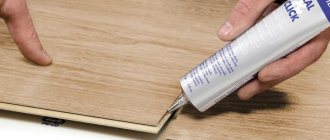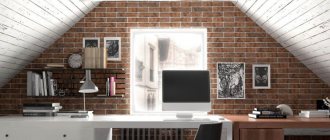Plaster in modern design
Gypsum is a natural mineral that has been used in construction for thousands of years. It is known that the ancient Egyptians already held together the blocks of the pyramids (including the pyramids of Cheops) with gypsum mortar. Later, gypsum began to be used for castings and impressions, making surfaces of any shape: ceiling cornices, bas-reliefs and other decorations.
Today, the use of gypsum has become more diverse. Natural material is mined in quarries, subjected to heat treatment and crushed into powder. Depending on the fineness of grinding, construction (alabaster) or molding gypsum is obtained; Medical gypsum is obtained from highly purified raw materials.
Beige brick in a classic living room Source pinwin.ru
In the design of premises, gypsum ceiling parts, cornices and chandelier sockets are widely used, but decorative gypsum tiles are the most widely used. It is used for finishing walls and ceilings and is called decorative artificial stone.
Tile decor is suitable for decorating any room, from the living room and office, to the kitchen and corridor. With its help, they create furniture elements, decorate fireplaces, niches and arches. The material is interesting because it is able to accurately convey the relief and texture of natural surfaces. Therefore, varieties that imitate stone and brick are especially successful.
Design of a doorway Source design-homes.ru
Arguments for and against gypsum
Usually, when finishing one or more walls in a house, they decide to use a material such as gypsum tiles for interior decoration. Which is very correct in such a situation. After all, she has many advantages.
For example, the affordable cost of gypsum is the first plus. This allows you to significantly minimize the cost of cosmetic repairs. In addition, having free time and some equipment, it is quite possible to make such cladding elements with your own hands.
The second argument in favor of gypsum is the environmental safety of the material, which is made from natural soft minerals and is absolutely harmless to health. The centuries-old tradition of using it in construction only confirms this.
The third plus is the practicality of the material, its flexibility for processing.
But, despite a lot of factors indicating the benefits of using gypsum finishing, it also has disadvantages. For example, fragility is not its best quality. It is easy to damage it during the repair process. It may not withstand excessive force upon impact.
The unhindered absorption of water by gypsum has already been mentioned above. It is for this reason that gypsum is not suitable for façade street work and for repairing premises with high heat and humidity conditions without pre-treatment.
Advantages and disadvantages
The popularity of gypsum tiles for interior decoration is due to its following advantages:
- Light weight. Gypsum tiles are lighter than other finishing materials. This means that it minimally loads the base and can be used for cladding the thinnest partitions; When laying it, you do not need to use reinforcement.
- Availability. Gypsum is a common mineral in nature, relatively easy to process, so the tiles are cheap.
Ceiling plaster decor Source design-homes.ru
- Easy installation. The tiles can be laid on any surface and do not require adjustment; if necessary, it can be easily trimmed with a hacksaw or jigsaw. For masonry, glue or liquid nails are used.
- Environmentally friendly. The material is based on natural ingredients, so the tiles do not emit substances that affect human and animal health.
- Microclimate adjustment. Gypsum is a porous material, so it is able to absorb excess moisture and release it if the air in the room becomes dry.
- Performance characteristics. The tile has good soundproofing qualities, it is durable and fire-resistant.
Modern style bedroom interior Source hzcdn.com
- Design possibilities. A significant advantage of the material is its realistic surface texture and variety of colors and textures. On the market you can find products that imitate any type of stone and brick.
The main disadvantage of gypsum decorative tiles to look like stone or brick is their poor tolerance to moisture, temperature fluctuations and mechanical influences (a careless blow can cause a chip or crack). The surface lined with relief material is quite difficult to care for. To protect the decor from dust and dirt, it is coated with a layer of special varnish, which means additional expenses.
Wall design in the living room Source archilovers.com
Dropped ceilings
The modern suspended ceiling system has not changed much since the 1960s and is still the most common type of ceiling used in the design of commercial and residential buildings. It has many strengths, which include low price, flexibility, quick installation, acoustic properties, adaptability for lighting and mechanical systems, and easy access to the plenum.
Typically, they were used to conceal mechanical systems such as ducts and pipes, giving the overhead space a clean, monolithic appearance. Today, the open ceiling trend is more popular, especially in commercial interiors, despite the benefits of gypsum ceiling systems.
Looks good on the ceiling
Research has shown that adding design elements to the ceiling plane can have a significant impact on the overall ambiance of a space, and can create a feeling of openness, privacy, intimacy or even energy. Additionally, a life cycle analysis study of ceilings versus open styles found that while initial installation costs are higher for suspended ceiling systems, energy and maintenance costs are lower than with exposed designs.
Suspended ceiling systems using gypsum ceiling tiles present a huge opportunity for designers and architects to create impact and visual interest in interior decoration, as well as solve a number of performance, safety, and overall appearance issues.
Main characteristics
Gypsum ceilings are a ceiling structure made of tiles, panels or blocks that can be adjusted in height for easy installation of all types of pipes, insulation materials, heating and lighting devices. They are also easily adaptable to special construction requirements such as:
- round ceilings;
- domes;
- sloping ceiling;
- recessed lighting, etc.
Stucco decor in the interior
They are a secondary structure that is attached to the main ceiling. It is a compatible independent structure, ready to paint, lightweight, excellent sound absorption, fireproof, economical. In addition, gypsum ceiling tiles with plastic coating on the front side and aluminum coating on the back side are durable and wear-resistant. It can also be washed with regular household detergents. Offers good sound insulation, water repellency and paint that will not fade when exposed to direct sunlight.
Gypsum ceiling design
Repeating modules (panels, slabs, blocks) are suitable for any shape and can be trimmed if necessary. Such a ceiling will improve indoor air quality and will be easy to use and install.
Installation principles
The suspended ceiling is slightly lower than the main one, this allows you to hide all the wires from the chandeliers and effectively place spot, recessed lighting. Installation takes place according to the principle of a frame system. After installing the frame, work with electrical wiring and connecting future lighting with the output of the corresponding wires follows.
Installation takes place according to the principle of a frame system
The frame may consist of square or rectangular divisions, depending on what type of architecture and design is needed . Sometimes ceiling tiles are cut to accommodate irregular or round light fixtures. In other cases, it may not be necessary to use tiles in place of the lighting fixture. In the third case, they buy a special ceiling rosette made of plaster, used for chandeliers. When choosing ways to place lamps, most designers are guided by specific needs.
One of the many advantages of this material is the ease with which it can be installed in new or existing premises. Installation on the frame occurs in a very short period of time without loss of acoustic or insulating characteristics.
Lightweight and easy to care for
Most tiles do not require special cutting tools and are compatible with a variety of adhesives and installation methods. Additionally, many products come with a removable layer for added protection during installation.
The ceiling can radically change any interior
Features of the material
High-quality gypsum tiles are produced on modern production lines. During the process, temperature and humidity are constantly monitored, making the tile material light and durable.
The main component of the mixture is gypsum; it can differ in grinding fineness and color (from pure white to light gray). The quality of the gypsum affects the elaboration of the relief, as well as how contrasting the color of the surface will be. The mixture also includes sand and water.
Decorating slopes on a former balcony Source lakbermagazin.hu
See also: Catalog of companies that specialize in finishing materials and related work
The production process takes into account the natural properties of gypsum; To improve them, additional components - modifiers - are added to the mixture. Thanks to modifiers, after drying, the tile acquires additional strength and becomes more durable. Such cladding is less susceptible to chipping and crumbling during operation. The following additives are used for improvement:
- Plasticizers. They optimize the gypsum-water ratio; as a result, moisture absorption decreases and the strength of the material increases.
- Water repellents. By reducing water absorption, they give the products additional water-repellent properties.
- Fiber fiber. Polypropylene fiber is a reinforcing additive that increases the fracture and bending strength of products. As a result, the strength of the tile increases by 50%.
Decor with a volume effect Source modernplace.ru
Manufacturers offer decorative material in two versions: in the form of individual rectangular elements or in the form of blocks of several such elements. Blocks usually have a relief, well-developed surface; one block consists of several elements in the form of bricks or stones. The sizes of gypsum tile products vary widely:
- Tiles imitating brick. The length of the element is in the range of 19-28 cm, width - 6-10 cm.
- Stone imitation tiles. Length is 21-37 cm, width – 9-10 cm.
- Corner elements have a side edge length of 7-12 cm.
Blocks with geometric patterns Source pinimg.com
Laying decorative stone with your own hands
Poorly laid tiles can ruin any result, even if you purchased the most expensive and incredibly beautiful decorative tiles, the final appearance of which you had high hopes for. It follows from this that you need to approach your work with full responsibility.
Preparing the surface and tiles for work
Before starting work, you must first properly prepare the surface. To do this you should:
- Clean the wall or other area from the old coating, level it if necessary;
- Impregnate the surface with a special primer;
- Following the instructions, dip each tile into a container with primer for the specified time;
- Lay a couple of rows of tiles on the floor, swap them if necessary until each tile fits snugly against the others, do this until you achieve the most even layout;
- If necessary, adjust each piece of tile to the size, cutting off the excess part. The cut is made at an angle so that the back side becomes narrower;
- If there are beads on the edges that were formed during the production of the tiles, they should be removed. Using another tile, run its back side along the corner where there is a bead.
Marking the wall for tiles
Depending on the tile used, the markings will be different for each. For example, the method of laying gypsum tiles imitating brick requires a seam.
In this case, using a building level, draw three horizontal lines from below, leaving a distance of 2-3 mm from the bottom. from the floor. The height between the lines should be equal to the width of the tile plus the seam.
After three rows have been laid out, you need to make sure that the markings are done correctly and visually everything looks smooth. If there are no comments, we mark the remaining part of the wall with the same step.
Marking for gypsum tiles imitating natural stone or, as it is sometimes called “wild” stone, is done according to the same scheme. Only instead of three lines, one is drawn, since the tiles are laid without a seam. The first row will serve as a guide and level for the rest.
How to choose a good glue
Here, as they say, there is no glue for taste and color. Today, there is simply a huge selection of different adhesive compositions on the market (silicone or acrylic adhesive-sealant, gypsum mixture with PVA, polyurethane foam, etc.). However, experts recommend special gypsum glue or putty.
This adhesive is applied to the wall and to the base of the tile, resulting in better adhesion to the surface.
In addition, the primer impregnation of gypsum tiles, which we discussed a little above, further simplifies the laying process, since due to this the effect of capillary suction is significantly reduced.
Before mixing, make sure there are no hard lumps in the glue composition. If available, sift the dry mixture through a fine sieve.
Gypsum tile design
Interior gypsum wall tiles complement the chosen style and help give the room personality. Visually, the material is divided into the following categories:
- Under the brick. The more carefully designed the shape in which the tile is made, the more realistic the tiled surface will be. Thanks to its small thickness, imitation brick saves space, and the variety of shades allows you to choose decor to suit any style and any size room.
Variety of brick decor Source pinimg.com
- Under a stone. The tile reliably replicates the relief of hewn natural material and is externally indistinguishable from natural minerals. For internal cladding, a material that imitates wild stone, slate or quartzite from various deposits is often chosen; This is why the offerings on the market are so varied in surface appearance and shades.
- Under the tree. Material with the texture of tree bark looks expressive in the decoration of living rooms. Here, not only the surface detailing is important, but also the choice of color palette.
Stone decor in the dining area Source remontbp.com
- 3D tiles with geometric, mosaic or abstract front surface. Material with a three-dimensional effect is used to create accent surfaces, while the interior acquires a touch of unusualness and exclusivity.
- In addition to materials that imitate natural textures, tiles with a smooth surface or with a pattern are available for sale. Unobtrusive geometric or floral patterns are used as a pattern, which are easy to fit into different interior styles.
Wood accent wall Source aviarydecor.com
What to look for when choosing tiles
When choosing gypsum tiles yourself, it is very important to pay attention to the following characteristics:
- The material must be made of high-strength gypsum grades G-16, G-19 with the addition of a plasticizer. Check this information with the seller;
- If possible, give the tiles a small check. Try to break one tile with your hands; if this requires a minimal amount of effort, then this option is definitely not for you. You can also rub the back side of the tile on a rough surface; the plaster should not crumble;
- Color saturation is also important. Too bright indicates that the tile most likely has undergone surface painting and no pigment substance has been added to the composition. Over time, such tiles will lose their original beauty, fading in the sun. It is better to entrust the creation of the desired shade to experienced colorists who use high-quality paint and professional equipment.
Tile color
The range of decorative gypsum materials according to color can be divided into two groups:
- White tiles for painting.
- Factory painted tiles.
Each variety has its own advantages. White gypsum stone or brick costs less than colored ones, so you can save on materials. Sometimes white decor fits into the interior design, in other cases the surface is painted independently. This allows you to show your creativity and create an exclusive design.
Original 3D tiles in the recreation area Source amazonaws.com
Acrylic paint is used for decoration; if there are several colors, they are applied in layers, sequentially. After the last layer has dried, the cladding is covered with one or two layers of colorless acrylic varnish. The protective layer will protect the decor from scratches and make it easier to care for.
Factory painted tiles are an opportunity to create a finished interior without delay. Budget varieties are painted on the surface, higher quality ones are painted throughout the entire mass. Products painted in the mass are more expensive, but have fewer problems during operation. Damage to the surface does not attract attention: there will be no bright white spot at the site of an accidental chip.
Painting the surface by hand Source otdelka-expert.ru
The palette of cladding, stylized as brick or natural stone, has dozens, if not hundreds of colors in different collections, and they are updated every year. White color is the basic color, but materials in popular natural shades are also on sale: beige, light gray, reddish, sand palette. Light colors are more popular, but there are solutions in dark colors: brown, dark gray, even black.
Some types of gypsum tiles have a more expressive appearance by combining several shades. The decor looks more realistic and allows you to create a surface that imitates, for example, old brick. This type of finish creates the sense of time needed in vintage and loft interiors.
Decorative brick in living room design Source domsmam.com
Materials and tools used
Before starting work, you must prepare everything you need. To work, you will need brushes with metal bristles to remove the old coating, paint brushes and rollers, a hacksaw for metal, a file, an airbrush for finishing, liquid nails, concrete contact, acrylic-type primer, tinting paste, a plumb line and a building level.
The influence of color on the interior
When choosing decorative gypsum tiles for interior decoration, you should take into account not only the color of the material, but also the parameters of the room for which it is intended. To ensure a balanced interior, it is useful to remember the following color features:
- Light shades have the ability to visually expand the boundaries of space. This opportunity should be taken advantage of if the cladding will be carried out in a small room.
- For a large studio-type room, the shade is not important, and the choice depends only on the style decision and tastes of the owners. There are many excellent interiors in the loft style, for the decoration of which tiles were chosen, stylized as old dark brick.
Light tiles in the hallway Source horoshijpotolok.ru
- If you want to make the interior more cozy, choose shades from a warm palette: beige, milky, terracotta, red. They will look especially good in a north-facing room.
- For a room facing south or southeast, you should choose tile material in a cold range of white, gray and bluish tones.
- White and light gray tiles are considered universal. It can be easily combined with any furniture; it’s easy to match wallpaper, textiles and other decor.
Warm shades make the interior more comfortable Source mykaleidoscope.ru
Stylistic finishing techniques
Decorative stone laying can be done in various variations, which will only be desired by the owner of the house. For example, it will look original in an apartment, but especially in a spacious house, decorating the doors with decorative stone in the style of a passage to a medieval castle, as shown in the photo.
If it is supported by an interior made of antique furniture and paintings and other relevant attributes, then a striking effect is guaranteed. The most successful execution can be achieved if you decorate the arch like this. An imitation of rough stone masonry, if supported by the same fireplace, will become the highlight of the room.
Imitation of brickwork is most often used when finishing doorways. In this case, the edges should be done in a torn style, without matching the ends of the tiles with each other. The shades of the tiles that blend into each other look interesting.
Imitating the entrance to a cave is an interesting and unique technique that will be relevant only in some cases. It is created by laying massive stones.
Greater naturalness can be achieved if the design is made using decorative stone in the form of pebbles or sandstone. Such a light finish will go well with wicker furniture, wood, flowers and natural interior elements.
Methods of use
Gypsum materials imitate various textures, including plaster, so they are readily used both for finishing the walls and as a replacement for ceiling cladding. They are not suitable for cladding facades, rooms with high levels of humidity and staircases. For such surfaces, choose brick and decorative stone made from a cement-sand mixture.
Wild stone at the head Source apollo.com
Gypsum tiles in the interior should fit into the color palette and composition of the room. The following options for its use are possible:
- In the living room. The main design technique is an accent wall (or part of a wall). The rest of the wall space is made neutral: monochromatic and as even as possible. For relief decoration, the correct lighting angle is important; it should not be frontal, but falling from above and slightly from the side. Decorating the fireplace with plaster decor also looks appropriate.
Decorating a fireplace in the living room Source pinimg.com
- In the kitchen. In the kitchen space, plaster cladding is used only to decorate the ventilation duct or dining area. The material is not used in finishing the apron and, especially, the sink.
- In the bedroom. Plaster is used to cover the wall at the head of the bed or opposite the bed. The finishing is made light, often white; It turns out appropriate and stylish.
- In the corridor, hallway. In small rooms, gypsum decor is used mainly as edging for door and arched openings.
Decorating a mirror at the entrance Source prom.st
The procedure for designing the opening
Decorating the slopes of the front door with decorative stone is done using the same technique as the interior door. The only difference is in the choice of material - not every imitation is suitable for these purposes.
Preparing the base
- The excess is removed - old paint, plaster, and in some cases the door is also dismantled if an arched opening is planned. The task is to achieve a flat and durable surface on which the tiles will adhere securely.
- Marking the wall according to the diagram for fastening the stones.
- Applying notches (grooves) to the base. This increases its adhesion to the cladding.
- Treat all segments to be finished with a primer. The goal is the same; Plus, this composition prevents the absorption of moisture by the wall material.
- After drying, it is advisable to apply concrete contact to the base. This product will further increase the level of adhesion, which means that the fixation of the stone will be as reliable as possible.
Door jamb trim
- The tiles are laid out on the floor according to the diagram. This will make further installation easier and will allow you to once again evaluate the correctness of the choice of location of the fragments.
- Removing the baseboard. The stone is laid to the floor, and therefore the lower molding will be a hindrance; Upon completion of the work, it is easy to return it to its place.
- Determination of the horizon line. Task: to ensure that all seams are located in this plane. Using a level and a long strip, a line is drawn on the wall that corresponds to the lower cut of the stones of the first row.
- Fastening the tiles. Cladding work always starts from the corner. To fix the samples, adhesives recommended by the manufacturer are used (tile, “liquid nails”).
The nuances of the work depend on the design intent. During the finishing process, stones will have to be cut, edges polished, and bevels made; but these are details that are not of fundamental importance. If platbands are installed later, then indentations are made for them.
- Finishing the joint
To make the stone more natural, it is advisable to spray the prepared composition over the entire area of the cladding, as well as adjacent areas of the wall: acrylic varnish + tinting paste. The mixture is diluted with water to the desired consistency and applied to the surface. It is not difficult to choose a recipe.
Decorating a jamb with decorative artificial stone does not require professional training. But if this option is unacceptable for some reason, you can use materials that successfully imitate such a finish. There is a large assortment of polymer texture panels on the market, special wallpaper of the appropriate texture; working with them is much easier, as well as updating (reinstalling) damaged samples. But still, they are not able to completely replace decorative tiles. This design solution can be considered the most preferable.
Briefly about the main thing
Decorative gypsum tiles are a popular material in modern private construction due to their availability and successful combination of performance characteristics. The most popular materials imitate natural stone and brick.
Manufacturers offer white products that can be used in their natural form or colored to suit your taste. Factory-painted tiles throughout the entire volume do not require any finishing and are good at masking minor surface damage.
Rooms decorated with gypsum tiles look elegant and presentable. Tiles are used to decorate ceilings, create accent walls, lining fireplaces, and edging arches and doorways.
Ratings 0
Using PVC panels for subsequent finishing of doorways
To make the doorway look more original, use standard PVC plastic panels. This is due to the abundance of color shades of the material, as well as the ease of its use in any room, room or other space. Plastic panels can often even imitate the surface of stones, while their cost is several times cheaper.
PVC panels of different colors for finishing doorways
Let's look at the main advantages:
- Low cost compared to all other materials.
- Fairly simple care.
- Installation is carried out on your own without assistance.
- Huge selection of color shades and textures.
Most often, when using PVC panels, finishing is done with color sheets that have warm woody shades. The convenience of installing such finishing elements is that they can be easily attached to liquid nails, without resorting to the use of screws, nails and cement mortar, which greatly facilitates the installation procedure, which can be done independently without much difficulty.
Important. Mounting these elements at the front door is irrelevant, since unlike stone and wood, plastic is quite fragile and the slightest mechanical damage can lead to a crack.Where it is used - design features
When decorating walls or ceilings with this material, moderation should be observed. A fragmentary finish will look most textured. It will be especially impressive against a smooth surface. If you cover the entire wall with tiles, it will lose its expressiveness and will look too heavy and uninteresting. Therefore, it is better to limit yourself to one or several accents that will set the mood of the entire interior.
The tiles are perfect for creating an accent area. It can be used to decorate the wall behind the TV, highlight a dining or sleeping area, or emphasize the convexity of an architectural element - a fireplace, column, arch.
Do not use tiles in different rooms or on two or more walls at once. It will be too much. The decoration is very active in itself, so it is better to limit yourself to one element in the apartment.
In the hallway, plaster bricks are used to cover the section of walls near the door and the corners. The material is applied partially, simulating exposed stone. Most often, the fragments are laid out in a ladder, or randomly, placing them in a horizontal position. To frame the entrance, the products are laid perpendicular to the doorway. When finishing the lower sections of adjacent walls, masonry is done according to the brick principle.
Color scheme and design
The decorative properties of gypsum tiles are beyond doubt.
It is suitable for finishing rooms in different styles:
- all types of urbanism, including loft, hi-tech or techno;
- oriental flavor (Moroccan and Turkish, Chinese and Japanese);
- eclectic varieties where design traditions from different eras and cultures are mixed;
- country, where “naked” brick or stonework is cultivated;
- minimalism.
The most popular is white gypsum tiles.
Common color variations:
- white color (base without adding color);
- milky or creamy;
- beige tone with all transitional shades;
- sand;
- all shades of chocolate and terracotta;
- gray-green and lilac-gray;
- pistachio;
- brown tones;
- whole palette of gray shades.
Visually, warm colors, beige with yellow, terracotta or chocolate are best perceived.
A “stone” wall or artificial brickwork is a hit with many interior styles. When choosing a shade, they are guided by the general design concept and the preferred range - in warm, cold or neutral tones.
Composition of gypsum tiles
The lightweight, versatile finish was developed as an alternative to heavy natural stone. Decorative tiles to look like crushed stone are made on a gypsum base. The only difference is the thickness of the plates and the design of the structure. Experiments were carried out on proportions and additives until a plastic composition for filling molds was obtained.
Each tile manufacturer has its own secrets regarding the production of gypsum products for decoration.
Today, artificial stone is produced on different bases:
- quartz;
- acrylic;
- plaster.
The decorative material contains not only the main components, but also inclusions in the form of sand, modifiers, and surface-active components. To make gypsum mixture use:
- 6 parts plaster;
- 1 part slaked lime (a little less citric acid);
- 0.7 liters of water for each portion of dry plaster.
- pigment (proportions are indicated in the instructions).
You can make your own gypsum tiles for cladding interior walls.
On sale you can find a ready-made mixture for making tiles at home. Usually thickeners and plasticizers are added to it; they make the gypsum stronger, but the mixture does not harden so quickly. The proportions and amount of water may vary - it is important to follow the technology recommendations.
Surface preparation and marking
The tiles are applied to the prepared base - bulges can lead to cladding defects. Small cracks do not need to be plastered; they will be hidden under the tiles.
Attention! It is useless to hide cracks caused by shrinkage of the house with a tiled covering; the next time it is displaced, the gypsum stone will begin to fall off.
Putty will be needed for difficult areas - pipe entrances into the wall, sockets and switches, places behind radiators. In the bathroom and kitchen, waterproofing is required at the junction of the wall and the floor. It is recommended to take care of these nuances before starting laying. Next, the coating must be treated with a primer to obtain maximum adhesion.
Prepare the wall properly for laying decorative tiles.
Ellinbrick
Ellinbrick decorative tiles from Monte Alba will add sophistication and modernity to the interior of the apartment. Features of Ellinbrick tiles:
- The surface covering comes with a gap.
- The glue used is Monte Alba.
- The tile is light weight, so it is fixed to the base quickly.
Gypsum tiles Ellinbrick - Gaps (seams) are filled with glue or special grout.
Tile length – 19cm, height – 4.7cm, thickness from 0.6cm. up to 07 cm, jointing up to 1 cm.
Tips for caring for tiles
Gypsum coating can be maintained using dry and wet cleaning. It is permissible to use a vacuum cleaner with a special attachment, soft-bristled brushes, and damp rags. Abrasive materials and aggressive detergents can cause irreparable damage to the surface. The varnish coating significantly reduces the risk of damage to the top layer. To ensure the finish is resistant to moisture, it is treated with a special impregnation. After applying this product, the cladding can be washed.
Main stage
After preparing the surface, markings are made. It is advisable to decide whether the colored fragments will fit freely or with a certain rhythm.
The pattern is laid out on the floor in advance to evaluate the distribution of dark and light plates. Preliminary marking will also help determine the location of the cutting, which is best prepared in advance, at least for several rows.
Use the services of specialists or their advice for high-quality installation of gypsum tiles.
Experts recommend a cement-based adhesive composition. The solution is applied to the wall with a comb, the tiles adhere better. Some of the glue is applied to the gypsum board.
Before preparing glue, it is important to study the proportions. Without compliance, it will be too thick or thin - the tiles may slide off the walls. Stirring with a construction mixer will get rid of dry lumps and air.
- We do the installation from below, so that the weight of the subsequent rows has a base; the plinth must be removed and worked directly from the floor. We check the horizontal level and correct it.
- The second row is also aligned horizontally. If it is broken, it can be corrected by additional application of the adhesive mixture or supported with inlays without removing it until it sets.
- Before laying subsequent rows, you need to file down the protruding parts of the lower level, correcting the protrusions at the seams. Remove excess solution with a spatula.
An interesting solution would be to make a partition from gypsum tiles to look like natural stone.
A little of the adhesive that creeps out at the seams can be left - to make the walls made of “torn stone” look natural.
